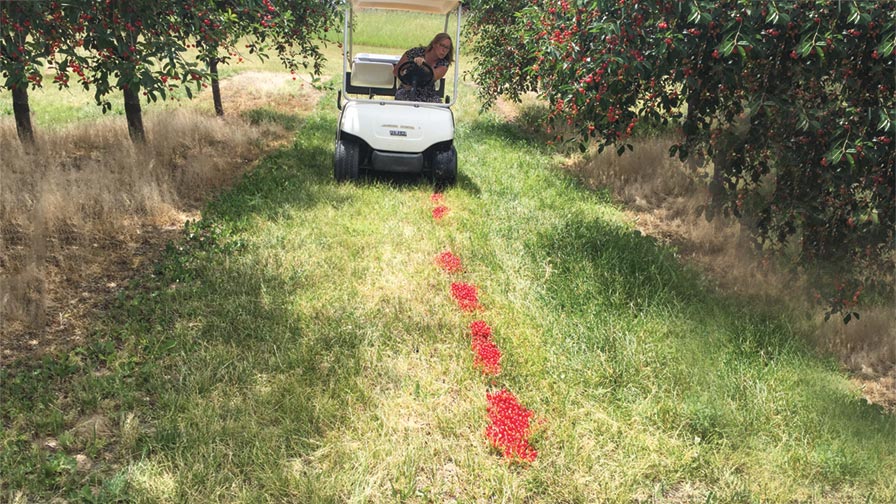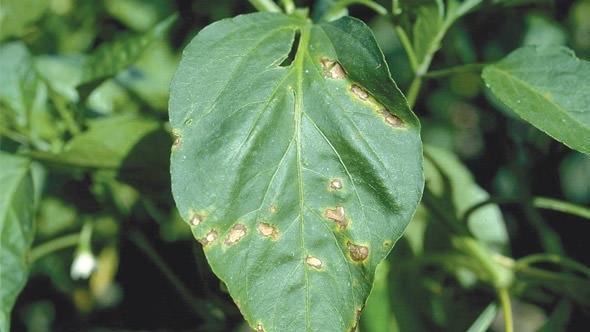Spotted Wing Drosophila: For Michigan, It’s A ‘Game-Changer’

Growers should remove unharvested cherries and destroy them to cut spotted wing drosophila populations, as Nikki Rothwell demonstrates with this golf cart.
This crop year has been the most challenging in Nikki Rothwell’s dozen years as Coordinator of Michigan State University’s Northwest Michigan Horticulture Research Center.
First, it was the hottest. Second, it was a huge cherry crop – both tart and sweet – the biggest since 2009. Third, a wicked hail storm hammered the crops of many growers, including Rothwell’s own cider apples.
“At my house (on the Leelanau Peninsula), we have a teeny little apple orchard,” she says, “and our apples got totally shredded.”
But even with all that, it wouldn’t have been nearly so bad if spotted wing drosophila (SWD) wasn’t such an ominous threat. It can explode so quickly, Rothwell says, that growers were spraying almost constantly.
“But even expensive spray programs don’t always work, there’s a lot of hit and miss, it’s unpredictable,” she says. “The pest is a game-changer for the tart cherry grower in Michigan.”
MRLs A Headache
Francis Otto of Cherry Bay Orchards in Traverse City wouldn’t disagree. One of the nation’s largest cherry growers, he farms 1,200 acres of tart cherries and 175 acres of sweet cherries at various locations in the state. The main thrust of his business is supplying Shoreline Fruit with the dried cherries sold at Costco stores.
Because many of those Costco warehouses are outside the U.S, Otto has to cope with the various maximum residue levels (MRLs) for pesticides permitted by other countries. But because he does farm in different parts of the state, he does have some enviable flexibility.
For example, this summer he was able to harvest 300 acres of tarts in Southwestern Michigan early, before SWD really took hold. Those tarts are destined for Europe.
“We’re really fighting the MRL issue,” Otto says. “Trying to keep SWD under control while meeting MRLs was a major problem this year.”
Because it’s cost-prohibitive for him to do blanket spraying, Otto has come up with a strategy in which he sprays alternate middles every three to five days.
“In the past we could stretch it out to 12 days, and it was not much of an issue,” he says. “Now, trying to juggle this is a logistics nightmare.”
He changes materials frequently to avoid resistance problems, and has found that Imidan (phosmet, Gowan) is working surprisingly well with MRLs. “They said you couldn’t use it 14 days before harvest,” he says, “but you can.”
Otto will use the alternate row strategy again next year, as it seemed effective. Despite the really big crop year, and the heat, he didn’t have SWD at a high enough level to be detected. But that doesn’t mean he won’t be watching like a hawk in 2017.
“You absolutely have to keep ahead of the curve; don’t let population numbers build up,” he advises. “You have to keep being proactive about keeping populations under control.”
Biggest Change In 50 Years
Another Michigan cherry grower, Jim Nugent, agrees that there is no getting around the fact that dealing with SWD is time-consuming and expensive. Some of the newer materials in particular are quite costly, but growers have to use them alternately for resistance avoidance. The problem with SWD is it’s so different from the pests cherry growers have dealt with in the past.

SWD: Small fly, big problem. (Photo credit: Elizabeth Beers, Washington State University)
“Any time you have a pest that can go from egg to adult in eight days, you are going to have so many generations. Cherry fruit fly has only one generation per year, as does the northern strain of plum curculio, so they are much slower to develop resistance,” he says. “We’ve got to minimize the use of insecticides as much as possible, but we’ve got to control this thing.”
Nugent is a smaller grower, farming 40-plus acres of tart and sweet cherries in Sutton’s Bay, which is also in Northwest Michigan. In fact, Nugent was in the position in Rothwell now holds, retiring 12 years ago after 31 years.
The biggest change the industry veteran has seen in the tart cherry business was the introduction of automated harvest in the late 1960s. In the half-century since, nothing has had anywhere close to the impact on the industry than has SWD.
“It just seems to be getting more and more of an issue every year. Growers this year did a great job of controlling it, but we’re just having to spray a lot more than we ever did to get control,” he says. “This is a game-changer, the biggest in my career.”
Midwestern Hospitality
As to why SWD is so much tougher for cherry growers in Michigan than in California — where it was first found in the U.S., in 2008 — Nugent agrees with Rothwell’s theory that there are so many wild plant hosts in the East and Midwest, SWD has a lot more available habitat. The cherry orchards of California, and Washington, for that matter, are largely surrounded by arid land.
Nugent’s orchards were surrounded by mulberry, “which turns out to be a really good one to build up populations early and then move into the orchards,” he says.
At Rothwell’s suggestion, he cleared out a lot of mulberry trees after the 2015 crop year. But that’s not a long-term answer. Clearing the trees allowed more sunlight in, which of course laid the groundwork for other wild hosts to flourish. SWD has a lot of wild hosts, Rothwell notes.
“In California, they don’t have wild hosts,” she says. “Here we have wild raspberries, honeysuckle, mulberries, gooseberries, you name it, for hosts. They will build in wild hosts. It’s my hypothesis. I’m still collecting and analyzing the data — but that’s my hypothesis.” ●









